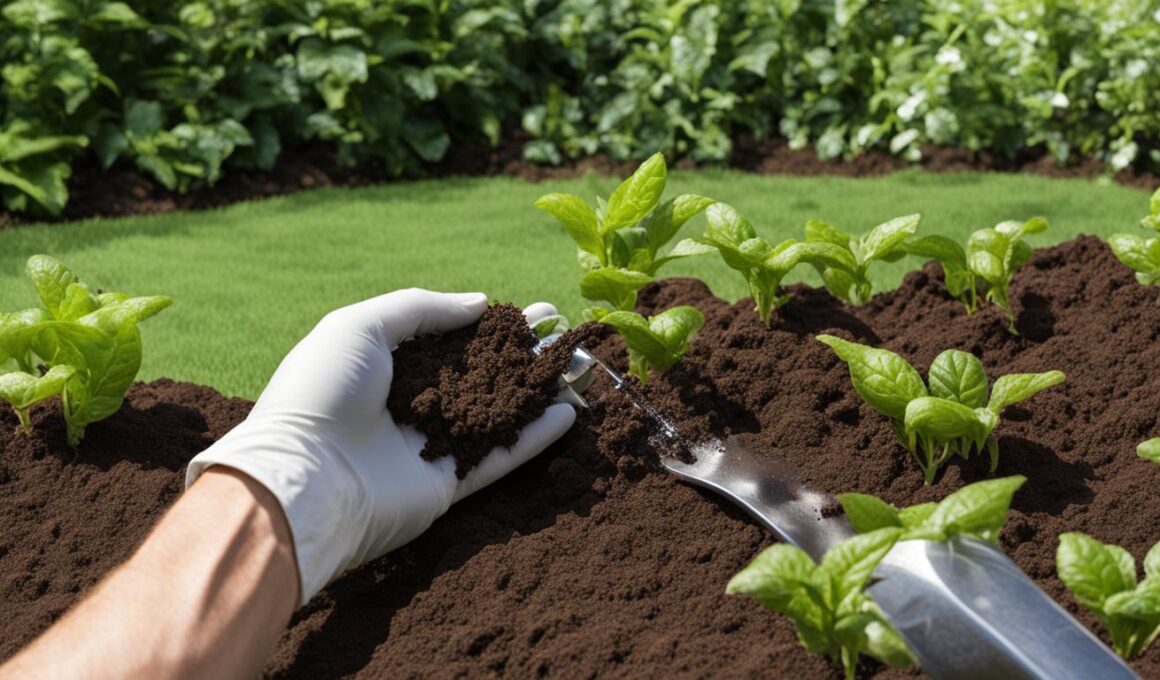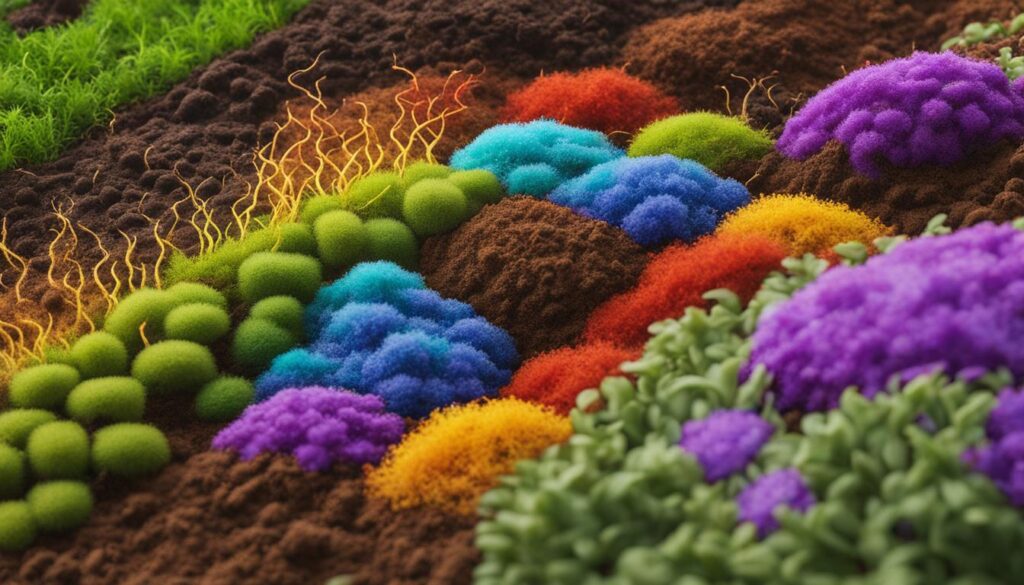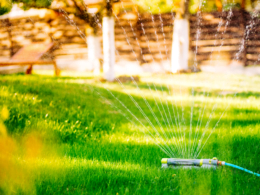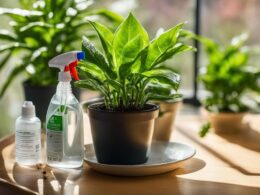Welcome to our guide on using nematodes for organic pest control in your lawn and garden. Nematodes are microscopic roundworms that can effectively eliminate soil-dwelling pests. By harnessing the power of these beneficial organisms, you can create a pest-free environment while maintaining an organic approach. In this section, we will explore the basics of nematodes, their life cycle, and how they can be purchased for use. Let’s dive in!
Post Summary
- Nematodes are microscopic roundworms that help control soil-dwelling pests.
- They enter the bodies of pests and release bacteria, killing the host within 48 hours.
- Nematodes have a life cycle with six stages, including egg, juvenile stages, and adult.
- Purchase nematodes from garden centers or online retailers.
- Beneficial nematodes are a natural and organic pest control solution.
What Are Beneficial Nematodes?
Beneficial nematodes are microscopic segmented roundworms that occur naturally in soil worldwide. These nematodes are commonly referred to as entomopathogenic nematodes and belong to the families Steinernematidae and Heterorhabditidae. They play a crucial role in organic pest control by targeting soil-dwelling pests.
Unlike harmful nematodes that attack plants, beneficial nematodes enter the bodies of soil-dwelling pests through openings in their skin. Once inside, they release specific bacteria that poison and kill the host pest within 48 hours. The dead pest serves as a food source for the nematodes, allowing them to grow and reproduce.
Beneficial nematodes have a life cycle that typically consists of several stages, including eggs, juveniles, and adults. Depending on the species, they can be effective in controlling more than 200 different soil-dwelling pests such as grubs, caterpillars, weevils, and beetles. The use of entomopathogenic nematodes offers a natural and environmentally friendly solution to pest problems in gardens and lawns.
Beneficial nematodes are microscopic segmented roundworms that enter soil-dwelling pests and release bacteria that kill the host within 48 hours.
What Are Beneficial Nematodes?
Beneficial nematodes are microscopic segmented roundworms that naturally occur in soil worldwide. To effectively control soil-dwelling pests, specific nematode species known as entomopathogenic nematodes are used. These nematodes enter pests through their skin, releasing bacteria that poison and kill the host. With a life cycle consisting of different stages, beneficial nematodes can target a wide range of soil-dwelling pests, providing an organic and environmentally friendly solution to pest control.
Getting Started: What You’ll Need
To effectively use beneficial nematodes for organic pest control, you’ll need a few essential items. Here’s a list of what you’ll need:
- A watering can
- A hose-end sprayer
- A backpack sprayer
- A pump sprayer
- A large bucket
These tools will help you apply the nematodes accurately and efficiently to your lawn or garden.
Comparison of Aeration Methods
| Aeration Method | Description | Effectiveness |
|---|---|---|
| Garden Fork | Manually insert fork tines into the soil at regular intervals and rock back and forth. Suitable for small-scale aeration. | Effective for loosening compacted soil in smaller areas. |
| Aerator Shoes | Strap-on shoes with spikes or hollow tines that create holes as you walk. Suitable for larger areas. | Provides moderate aeration but may not penetrate deeply into compacted soil. |
| Core Aerator | Machine that removes small cores of soil, allowing for deeper aeration. Suitable for large-scale aeration. | Highly effective for relieving compaction and improving soil structure. |
Mixing the Nematodes with Water
When it comes to using beneficial nematodes for pest control, it is important to properly mix them with water before application. The method you use for mixing will depend on how the nematodes are packaged, whether in granule form, clay, or a sponge. It is crucial to follow the instructions provided with the product to ensure the nematodes are mixed effectively.
Note: Properly mixing the nematodes with water ensures that they are evenly distributed and ready to be applied to the soil.
“The water acts as a carrier agent to spread the nematodes and help them reach the soil where the pests are located.”
Once you have obtained the beneficial nematodes and the recommended amount of water, you can begin the mixing process. Make sure to use clean water that is free from any harmful chemicals or additives. You can use a large bucket or any container suitable for the amount of nematode-water mixture you need.
Pro Tip: Shake or stir the nematode-water mixture gently to ensure the nematodes are well distributed throughout the water.
Remember, the water serves as a carrier for the nematodes, helping them reach their target in the soil. Ensure the nematodes are mixed thoroughly with the water before applying them to maximize their effectiveness in controlling soil-dwelling pests.
Applying Nematodes to the Lawn and Garden
Once you have prepared the nematode-water mixture, you are ready to apply it to your lawn and garden. There are a few methods you can use, depending on the size of the treatment area and your preference.
If you have a small area to treat, a watering can is a convenient option. Fill the watering can with the nematode-water mixture, ensuring that the openings are wide enough for the nematodes to pass through. It’s important to shake the can continuously while applying to prevent the nematodes from sinking to the bottom. Move systematically across the area, aiming for even coverage. If you need to refill the watering can, do so as needed to ensure consistent application.
For larger areas, a sprayer can be more efficient. Choose a sprayer that can handle nematodes without clogging. Fill the sprayer with the nematode-water mixture and adjust the nozzle for optimal coverage. Similar to using a watering can, shake the sprayer continuously during application to keep the nematodes well-mixed. Move methodically across the area, making sure to apply the nematodes evenly.
Regardless of the application method, it’s essential to achieve even coverage to ensure maximum effectiveness. By following these guidelines, you can ensure that the nematodes are distributed evenly across your lawn and garden, targeting the soil-dwelling pests and offering effective organic pest control.
Keeping the Soil Moist
After applying beneficial nematodes to your lawn or garden, it is crucial to maintain adequate soil moisture to ensure the establishment and effectiveness of the nematodes. Proper watering plays a vital role in creating a favorable environment for the nematodes to survive and continue hunting down pests. Here are some essential tips for keeping the soil moist:
- Lightly water the treated area every three to four days for about 10 days after applying nematodes. This helps maintain the desired moisture level in the soil.
- Avoid over-watering, as excessively saturated soil can harm grass and plants. It is important to strike a balance and provide enough moisture without causing waterlogging.
- If it rains during this 10-day period, you may not need to water the treated area. However, monitor the soil moisture and ensure it remains damp.
Remember, adequate soil moisture is crucial for nematodes to survive and continue their pest control activities. By following a regular watering schedule, you provide the necessary conditions for nematode establishment and long-term effectiveness.
Benefits of Keeping the Soil Moist
Maintaining proper soil moisture offers several benefits when using beneficial nematodes for pest control:
- Enhances Nematode Survival: Nematodes require a moist environment to survive and thrive. By keeping the soil adequately moist, you increase the likelihood of nematode establishment and long-term effectiveness.
- Optimizes Pest Control: Moist soil provides an ideal hunting ground for nematodes, as it allows them to move freely and locate soil-dwelling pests more effectively.
- Supports Plant Health: Adequate soil moisture is essential for the overall health and vitality of your plants. It ensures that they receive the necessary hydration to grow and resist stress.
By understanding the importance of soil moisture and implementing a proper watering schedule, you can maximize the effectiveness of beneficial nematodes in controlling soil-dwelling pests, while also promoting healthy plant growth.
Tips for Maintaining Soil Moisture
| Tips | Description |
|---|---|
| Lightly water the treated area every three to four days for 10 days. | Provides consistent moisture for nematode establishment and survival. |
| Avoid over-watering. | Prevents waterlogging, which can harm plants and grass. |
| Monitor soil moisture after rainfall. | Adjust watering schedule accordingly to maintain desired moisture levels. |
*Please note that the image above is for illustrative purposes only and does not represent the actual nematodes or plants in your garden.
Reapplying as Necessary
Beneficial nematodes are a powerful tool for controlling soil-dwelling pests, but their effectiveness may vary depending on the pest population and environmental factors. To ensure complete pest control and maintain nematode effectiveness, it is recommended to reapply nematodes at least once after the initial application.
When reapplying nematodes, wait approximately seven to ten days to allow the first application to take effect. This waiting period allows the nematodes to consume the pests and reproduce, ensuring that the population remains active and effective. By reapplying nematodes, you can target any remaining pests and replenish the nematode population.
If the pest population persists after the second application, continue reapplying nematodes every seven to ten days until the pests are no longer present. It is important to monitor the pest population closely and adjust the reapplication frequency as needed. Keep in mind that it may take around two weeks to observe a noticeable decrease in the pest population, as nematodes require time to hunt down and consume the pests.
By regularly reapplying nematodes as necessary, you can maximize their effectiveness and ensure thorough pest control in your lawn and garden. Remember to follow the instructions provided with the nematode product and consider consulting with a professional if you encounter persistent pest issues despite reapplication efforts.
| Benefits of Reapplication | Considerations |
|---|---|
| Target any remaining pests | Observe pest population closely |
| Replenish nematode population | Adjust reapplication frequency as needed |
| Maximize nematode effectiveness | Consult with a professional if needed |
Conclusion
In conclusion, beneficial nematodes are an excellent option for organic pest control, providing an effective and environmentally friendly solution for managing soil-dwelling pests. By following the proper steps outlined in this guide, you can successfully utilize nematodes in your lawn and garden.
Remember, timing the application is crucial, as nematodes should be applied when the soil is cool and the sun is low. Preparing the soil by aerating and moistening it beforehand ensures optimal nematode effectiveness. Mixing the nematodes with water and applying them evenly across the desired area is essential for thorough coverage.
Once applied, it is important to keep the soil moist to support nematode establishment and continuous pest control. Lightly watering the treated area every few days for about 10 days after application promotes the survival and hunting abilities of the nematodes. Additionally, reapplying nematodes as necessary can help maintain control over the pest population.
In summary, nematodes provide an effective and organic alternative to chemical pesticides for pest control. By following the guidelines presented, you can harness the power of beneficial nematodes to effectively manage and control soil-dwelling pests in a safe and sustainable manner.
Can Nematodes be Used to Control Cutworms in Gardens?
Yes, nematodes can be effective methods for pest-free gardens, including controlling cutworms. These microscopic, worm-like creatures release bacteria into the soil that target and kill cutworms without harming plants. Nematodes are a natural and environmentally friendly solution for controlling pests in the garden.
FAQ
What are beneficial nematodes?
Beneficial nematodes are microscopic roundworms that are effective for organic pest control. They enter the bodies of soil-dwelling pests and release bacteria that kill the host pest within 48 hours.
Where can I purchase beneficial nematodes?
Beneficial nematodes are available for purchase at garden centers and online.
What equipment do I need to use beneficial nematodes?
You will need a watering can, hose-end sprayer, backpack sprayer, pump sprayer, or a large bucket to apply beneficial nematodes effectively.
When should I apply beneficial nematodes?
Beneficial nematodes should be applied in the early morning or evening when the soil is cool and the sun is low. Applying on a cloudy day can minimize UV exposure. The timing of nematode application depends on the target pest’s life cycle and the time of year when it lives in the soil.
How do I prepare the soil before applying beneficial nematodes?
Before applying beneficial nematodes, it is important to aerate and moisten the soil. Aeration loosens the soil, allowing nematodes to move around, while moist soil provides the necessary environment for nematodes to be effective.
How do I mix beneficial nematodes with water?
Beneficial nematodes should be mixed with water before application. The method of mixing depends on how the nematodes are packaged (granules, clay, or sponge). Follow the instructions provided with the product to ensure proper mixing.
How do I apply nematodes to the lawn and garden?
Fill a watering can or sprayer with the nematode-water mixture and apply it across the area you want to treat. Make sure the openings in the watering can or sprayer are wide enough for nematodes to pass through. Shake the container continually during use to prevent nematodes from sinking to the bottom.
How do I keep the soil moist after applying nematodes?
After applying nematodes, lightly water the treated area every three to four days for about 10 days to help establish the nematodes. Avoid over-watering to prevent waterlogging the soil and causing harm to grass and plants.
Do I need to reapply beneficial nematodes?
It is recommended to apply beneficial nematodes at least one more time after the initial application to ensure complete coverage and replenish the nematode population. Wait about seven to ten days before reapplying. If the pest infestation continues, continue applying nematodes every seven to ten days until the pests disappear.
Are beneficial nematodes an effective organic pest control option?
Yes, beneficial nematodes offer an effective and organic pest control option for managing soil-dwelling pests. By following the proper steps and guidelines, you can use nematodes to control pests in your lawn and garden in an environmentally friendly way.











